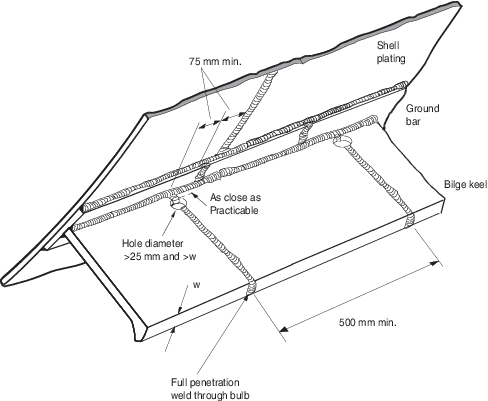5.1.1 The structure
and the attachment of the bilge keels to the shell plating is to be
thoroughly examined for possible fractures or evidence of damage.
5.1.2 The diagram
shows a typical bilge keel which may be found in use today on existing
ships. In carrying out inspection of all welded connections, emphasis
should be placed on locations where fractures may initiate typically
in the connection to the steel or ground bar at the bilge keel ends, see
Figure 7.5.1 Double plate bilge keel construction.
5.1.5 Butt welds
of perpendicular flat bar bilge keels should have a hole drilled through
the connection. This hole should have a minimum diameter of 25 mm
and extend beyond the fore and aft edges of the butt weld, see
Figure 7.5.4 Repair of perpendicular bilge keels. Where all butt welds have been
subjected to non-destructive examination and found satisfactory, the
holes may be omitted. In this case, for the information of Surveyors
at future surveys, a recommendation should be made for the insertion
of a note in the memoranda, viz. “continuous flat bar (if fitted)
and bilge keel butt welds ND examination (date) - stop holes not drilled.”
5.1.6 In assisting
with the assessment of the butt welding of perpendicular flat bars
and bilge keels, an examination can be made of the material in way
of these holes to verify the absence of defects, from which fractures
may initiate, such as lack of weld penetration.
5.1.7 Bilge keels
are not generally required for classification purposes and there may
be no objection to removal of a damaged length without replacement,
provided the watertight and structural integrity of the hull is unimpaired
and measures are taken to control the scarring of hull plating.
5.1.8 When it is
decided to dispense with a section of bilge keel after damage, the
new ends should be finished in a taper similar to existing ends, see
Figure 7.5.3 Bilge keel termination.
5.1.9 If the ground
bar is to be retained, then the connecting welds of the damaged/removed
section should be ground smooth.
5.1.11 Butts in
bilge keel should be kept clear of butts in ground bars. Butts in
ground bars are to be kept clear of butts in shell.
5.1.12 Repairs to
bilge keels are to be carried out in accordance with Figure 7.5.2 Repair of double plate bilge keel or Figure 7.5.4 Repair of perpendicular bilge keels as appropriate. In double plate bilge keels care is to
be taken so that only the outer bilge keel plate is attached to the
shell plating, ground bars, lugs and internal diaphragms are not to
be attached to the shell. Repair materials are to be of the same grade
and thickness as the original material.

Figure 7.5.4 Repair of perpendicular bilge keels